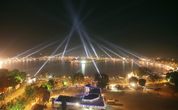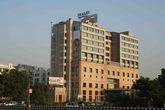Ahmedabad: A Patchwork Quilt
The area inside the fort is old Ahmedabad. Ahmed Khattu Ganjbaksha, the preceptor (Guru) of Sultan Ahmed Shah belongs to Sarkhej. Many new suburbs and new areas developed in the time of Muhmmad Begada. Dariyakhan established Dariyapur. Sarangpur, Kalupur, Rasulabad (Shah Alam), Isanpur and Navrangpura were established by Malik Sarang, Hazarat Shah Alam, Malik Isan and Navrang Miyan respectively. Jahangirpura was established during the reign of Jahangir. Thus, small and big areas developed as towns and at that time, about one hundred eleven areas or suburbs existed. We know some of them like Vadaj, Asarwa, Mithipur, Rajpur, Madalpur, Fatehbaug and Baug-e-Firdosh.The extention of Ahmedabad took place with the development - of Maninagar, Ellisbridge and Shahibaug areas. Maninagar was established in 1915 in the memory of Sheth Manilal Ranchhoddas.
If we survey different areas of Ahmedabad, we can see rural characteristics as well. For instance, the cows sitting in the middle of the streets, the camel carts, the vegetable vendors with bullock carts, donkeys with sand-sacks on their backs, followed by woman, the potter's whife. We can also watch `Chabutara` on the squares and a small temple somewhere around.
We may also see a rural scenario all around the town; people relaxing on the door steps or on wooden cots woven with jute strings, stray dogs, and occasionally some swines, the old clothes vendors on foot paths, women carrying vegetable baskets selling them. You can also find people without any traffic sense, walking or driving.
So, how does this city appear? Just imagine. Spread in an area of 464 square kilometers, the city includes many villages and they are joined with one another like a beautiful patch work in a quilt. These villages or areas have preserved their own existence and culture even today. It becomes quite evident when we visit them.










